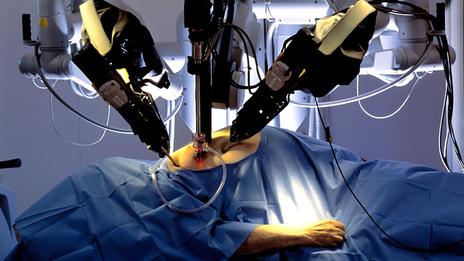Adrenal Robotic Surgery
- Home
- Adrenal Robotic Surgery

- Robotic Surgery for Adrenal Cortex Cancer and Functional Adrenal Tumors
Robotic radical adrenalectomy involves the complete surgical removal of an adrenal gland. The adrenal glands are two triangle-shaped organs that sit on top of the kidneys. They are responsible for producing a number of important hormones—substances that circulate throughout the bloodstream and help regulate blood pressure, sugar level, salt production and other metabolic functions. These hormones include cortisol, aldesterone, epinephrine (adrenaline), and norepinephrine. An adrenal gland that develops a benign functional tumor (so-called because it affects the way the gland functions) and begins producing too much of any one hormone may require a radical adrenalectomy in order to avoid long-term health problems. (As with the kidneys, humans have two adrenal glands and can function normally with one.) In other cases, it may be possible to treat the condition by performing a partial adrenalectomy, in which just the tumor is excised while the rest of the adrenal gland is left intact.
The entire adrenal gland is also removed if doctors diagnose or suspect a malignant tumor in the adrenal cortex (the outer part of the gland)—a rare condition known as adrenocortical carcinoma, adrenal cortex cancer, or simply adrenal cancer. Our surgeons at NYU Langone’s Robotic Surgery Center have had excellent results using robot-assisted adrenal surgery to remove benign and malignant adrenal tumors. The superior visualization and precision provided by the da Vinci Si surgical system are ideally suited to the delicate dissection and control of multiple feeding blood vessels required in radical adrenalectomy, and have the potential to decrease blood loss and reduce the time needed for the procedure. At the same time, the minimally invasive nature of robotic radical adrenalectomy means less post-operative discomfort and scarring and faster recovery for the patient.
- Advantages of Robotic Radical Adrenalectomy
Less blood loss. A robotic radical adrenalectomy results in significantly less blood loss during surgery, reducing the need for blood transfusions.
Less post-operative pain and scarring. The robotic procedure’s small incisions avoid the need for a large, disfiguring scar, resulting in significantly less post-operative discomfort and minimal surface scarring.
Shorter hospital stay and faster recovery. Most patients undergoing robotic radical adrenalectomy leave the hospital in 1 to 3 days versus 3 to 5 days for open surgery, and are able to resume normal activities within 1 to 2 weeks, compared to 4 to 6 weeks for open surgery.
The greater precision and visualization offered by the da Vinci Si enhances the surgeon’s ability to perform certain parts of the procedure, including isolating the adrenal gland from surrounding structures and controlling the multiple arteries and veins supplying the adrenal gland and tumor

